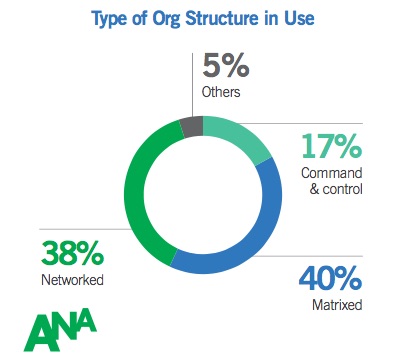What are the most commonly used marketing organizational structures? How do these approaches correlate to revenue growth?
To find out, the Association of National Advertisers (ANA) surveyed 303 marketers from a mix of B2C and B2B companies (mostly from midsize or large firms with 20 or more full-time marketing employees) in the United States.
Some 40% of respondents say their organization has a matrixed structure (functional silos exist but individuals have "dotted line" responsibilities across silos).
And 38% say their organization has a networked structure (cross-functional teams come together for specific projects).
Just 17% say their firm has a command-and-control structure (directives are issued top-down, and functions operate in silos).

Most respondents say their company's organizational structure is based on either product/service lines or on organizational function.
Smaller firms (under $500 million in annual revenue) are more likely to have organizational structures based on consumer segments and the customer journey, compared with larger firms.

Some 23% of firms with a command-and-control Marketing organizational structure have equal or lower revenue than their peers; 15% have higher revenue.
Some 40% of firms with a networked Marketing organizational structure have higher revenue than their peers; 30% have equal or lower revenue.

About the research: The report was based on data from a survey of 303 marketers who work for a mix of B2C and B2B companies. Most firms included in the survey are midsize or large firms with 20 or more full-time marketing employees in the United States.




